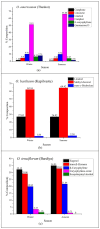Seasonal Variation in Essential Oil Composition and Bioactivity of Three Ocimum Species from Nepal
- PMID: 40942106
- PMCID: PMC12430450
- DOI: 10.3390/molecules30173581
Seasonal Variation in Essential Oil Composition and Bioactivity of Three Ocimum Species from Nepal
Abstract
The plants from the Ocimum genus, belonging to the Labiatae family, serve as important bioresources of essential oils (EOs) rich in biologically active secondary metabolites, widely used in medicine, food, and cosmetics. This study explored the volatile composition, enantiomeric distribution, and in vitro biological activities of EOs from three Ocimum species native to Nepal: O. tenuiflorum L., O. basilicum L., and O. americanum L. EOs were extracted via hydro-distillation and analyzed using gas chromatography-mass spectrometry (GC-MS) for chemical profiling and chiral GC-MS for enantiomeric composition. Hierarchical cluster analysis was performed for major chemotypes. Antioxidant activity was assessed using DPPH and ABTS assays. Antimicrobial efficacy was evaluated using the microbroth dilution method, and cytotoxicity was tested on NIH-3T3 (normal) and MCF-7 (breast cancer) cell lines via the Cell Counting Kit-8 assay. EO yield was highest in O. tenuiflorum (1.67 ± 0.13%) during autumn and lowest in O. americanum (0.35 ± 0.02%) during winter among all Ocimum spp. The major compounds identified in O. tenuiflorum were eugenol (32.15-34.95%), trans-β-elemene (29.08-32.85%), and β-caryophyllene (19.85-21.64%). In O. americanum, the major constituents included camphor (51.33-65.88%), linalool (9.72-9.91%), germacrene D (7.75-1.83%), and β-caryophyllene (6.35-3.97%). For O. basicilum, EO was mainly composed of methyl chavicol (62.16-64.42%) and linalool (26.92-27.05%). The oxygenated monoterpenes were a dominant class of terpenes in the EOs except for O. tenuiflorum (sesquiterpene hydrocarbon). A hierarchical cluster analysis based on the compositions of EOs revealed at least three different chemotypes in Ocimum species. Chiral GC-MS analysis revealed β-caryophyllene and germacrene D as enantiomerically pure, with linalool consistently dominant in its levorotatory form. O. tenuiflorum exhibited the strongest antimicrobial activity, particularly against Candida albicans, and showed notable anticancer activity against MCF-7 cells (IC50 = 23.43 µg/mL), with lower toxicity to normal cells. It also demonstrated the highest antioxidant activity (DPPH IC50 = 69.23 ± 0.10 µg/mL; ABTS IC50 = 9.05 ± 0.24 µg/mL). The EOs from Ocimum species possess significant antioxidant, antimicrobial, and cytotoxic properties, especially O. tenuiflorum. These findings support their potential application as natural agents in medicine, food, and cosmetics, warranting further validation.
Keywords: Ocimum spp.; biological activity; chiral GC-MS; hierarchical cluster analysis; seasonal disparity; volatile composition.
Conflict of interest statement
The authors declared no potential conflicts of interest with respect to the research, authorship, and/or publication of this article.
Figures






References
-
- Pandey A.K., Singh P., Tripathi N.N. Chemistry and bioactivities of essential oils of some Ocimum species: An overview. Asian Pac. J. Trop. Biomed. 2014;4:682–694. doi: 10.12980/APJTB.4.2014C77. - DOI
-
- Stefan M., Zamfirache M.M., Padurariu C., Trutǎ E., Gostin I. The composition and antibacterial activity of essential oils in three Ocimum species growing in Romania. Cent. Eur. J. Biol. 2013;8:600–608. doi: 10.2478/s11535-013-0171-8. - DOI
-
- Pérez-González C., Pérez-Ramos J., Alberto Méndez-Cuesta C., Serrano-Vega R., Martell-Mendoza M., Pérez-Gutiérrez S. Cytotoxic activity of essential oils of some species from Lamiaceae family. Cytotox.—Defin. Identif. Cytotoxic Compd. 2019:1–15. doi: 10.5772/intechopen.86392. - DOI
-
- Sajjadi S.E. Analysis of the essential oil of two cultivated Basil (Ocimum basilicum L.) from Iran. Department of Pharmacognosy, Faculty of Pharmacy and Pharmaceutical Sciences. Daru. 2006;14:128–130.
MeSH terms
Substances
LinkOut - more resources
Full Text Sources
Miscellaneous

